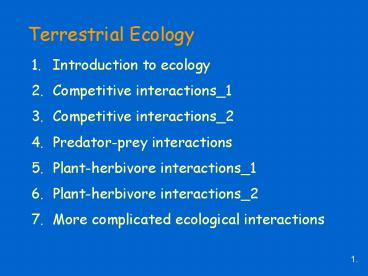Terrestrial Ecology - PowerPoint PPT Presentation
1 / 35
Title:
Terrestrial Ecology
Description:
More complicated ecological interactions. 2 . Terrestrial ... Opossum (Didelphis virginiana) South North America. Brushtail possum (Trichosurus vulpecula) ... – PowerPoint PPT presentation
Number of Views:667
Avg rating:5.0/5.0
Title: Terrestrial Ecology
1
Terrestrial Ecology
- Introduction to ecology
- Competitive interactions_1
- Competitive interactions_2
- Predator-prey interactions
- Plant-herbivore interactions_1
- Plant-herbivore interactions_2
- More complicated ecological interactions
2
Terrestrial Ecology
- Managing pest numbers
- Modifying pest behaviour
3
What is ecology?
- As distinct from
- Evolution
- Physiology
- Genetics
- Behaviour
4
What is ecology?
5
What is ecology?
1. Studying interactions
2. Within between
3. At various levels
4. To understand (explain)
6
Or
- Understanding biodiversity
- Why is there biodiversity?
- What affects it?
- How why is it affected?
7
Ecology broader context
Physiology
Genetics
Ecology
Behaviour
Evolution
8
Ecology broader context
- Maintaining homeostasis in
- deserts?
- estuaries?
9
Ecology broader context
- Phylogeny
- Populations across environments
- Metapopulations?
- Separate populations?
10
Ecology historical context
- Agriculture
- What causes plagues of insects?
- What increases crop yields and why?
- Human population growth
- Theoretical rates of increase?
- Misery and population size (Malthus)
- Natural history
- Observing the natural world
11
Natural History vs. Ecology?
- Observing describing the natural world
- Applying the scientific method to test your ideas
Natural history observations
Explanation
12
Ecology vs. Ecological Methods?
13
General factors affecting distribution abundance
- History
- Environmental conditions
- Resources
- Interactions (intra- and interspecific)
- Rates of birth, death, migration
14
History
- Where were their ancestors?
- Landmasses move
- Climate changes
- Landscapes change
- Animals may NOT be somewhere
- Havent got there
- Died out
- if region ? unsuitable
15
History
- Early mammals
- Eutherians
- Marsupials
- Monotremes
- Opossum (Didelphis virginiana) South ? North
America - Brushtail possum (Trichosurus vulpecula)(naturall
y) still confined to Australia
16
Environmental conditions?
- Abiotic factors varying in space time
- Temperature, rel. humidity, salinity, pH
- Hazards (volcanoes, tornadoes, turbulence)
- Can be modified by organisms
- e.g. temperature by grass cover
- Cannot be consumed
- cf. resources
- Impose physiological constraints on living
- Ecophysiology
- how organisms interact with environmental
conditions
17
Environmental conditions
- Affect individuals
- Patterns vary
18
Environmental conditions patterns of effects?
(a)
Examples?
- Temperature
- pH
19
Example (a) effect of temperature
(a)
20
Environmental conditions patterns of effects?
- Examples?
- toxins
21
Environmental conditions patterns of effects?
- Examples?
- Essential micronutrients
- copper
22
Example (b c) toxins micronutrients
Blidberg E. (2004) Effects of copper and
decreased salinity on survival rate and
development of Tridacna gigas larvae. Marine
Environmental Research, 58, 793-797.
23
Resources?
- Things that are consumed
- cf. environmental conditions
24
Resources?
- Include
25
Resources
- Affect individuals
26
Ecological niche (Hutchinson 1958)
- Conditions / resources essential for maintaining
a viable population - Each dimension represents a condition or
resource - ?n-dimensional hypervolume n-D
27
How to maintain a viable population?
- Individuals must
28
Ecological niche
- Fundamental niche
- Conditions Resources essential for maintaining
a viable population - Overall potential of a species
29
Realised niche Can it get there?
Examples?
Rabbits in Australia - thriving
Wallabies in UK - thriving
Possums in NZ - thriving
30
Realised niche effect of enemies?
Dingoes on mainland Australia devils extinct
3200y.a.
31
Niche
- Depends on
- Conditions
- Resources
- Enemies
32
(Why) is the concept of niche important ?
- Level of competition?
- ? niche overlap ? competition?
- Introductions extinctions?
- empty niche?
- niche overlap ? competition ? extinction?
- Role of species in ecosystems?
- Are all niches filled?
- Is biodiversity important for ecosystem
processes? Are all current species essential?
33
Main points
- Distribution abundance affected by
- History
- Environmental conditions
- Resources
- Interactions
- Births, deaths, migration
- Niche
- Fundamental
- Realised (add enemies)
34
General References
- Attiwill P. Wilson B. (eds) (2003) Ecology an
Australian Perspective. 1st edn. Melbourne,Oxford
University Press. - Begon M., Harper J. L. Townsend C. R. (1996)
Ecology Individuals, Populations and
Communities, 3rd edn. Blackwell Science Ltd,
Malden, Massachusetts. - Krebs C. J. (2001) Ecology the Experimental
Analysis of Distribution and Abundance, 5th edn.
Benjamin Cummings, San Francisco.
35
Sign up to groups































